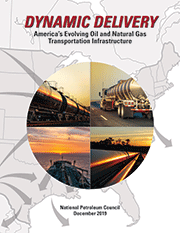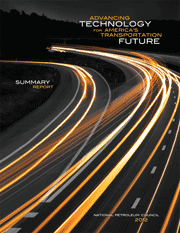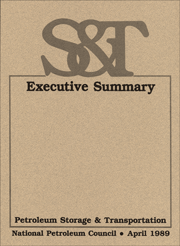|
|
|
Transportation
Dynamic Delivery: America’s Evolving Oil and Natural Gas Transportation Infrastructure (2019) The U.S. energy landscape has undergone dramatic changes in the past decade. The United States has recently become the world´s largest oil and natural gas producing country, which expands opportunities for exporting crude oil, natural gas, natural gas liquids, and refined products. America´s vast energy resources and the infrastr ucture to deliver them to market are vital to the nation´s economy and energy security. Dynamic Delivery, in its analysis through 2040, finds that public and private investment in new and existing pipelines, ports, rail facilitie s, and inland waterways will be essential in connecting America´s abundant energy supplies with domestic and global demand. Even in energy outlooks with low carbon scenarios, new infrastru cture is necessary to meet domestic energy needs. Project uncertainty caused by regulations and litigation are creating bottlenecks to energy delivery in some regions. Addressing climate change and creating greater regulatory certainty are critical to ensuring cost-effective and reliable energy supplies for consumers. The report also recommends regulations that enable new technology a nd will improve safety and environmental performance. The report is presented in a Summary Volume that includes the transmittal letter to the Secretary of Energy, the preface, and the executive s ummary, which presents the high-level findings and recommendations, along with a brief discussion of the supporting analyses. The Full Report Volume contains the Summary and four detailed chapters. In addition to the above chapters, the report contains a list, including abstracts, of the 26 topic papers that were developed to support the study proces s. Although not part of the study report, the Council makes these topic papers available online to provide access to detailed information that informed the study process. Printed report: View/download report: Click here to view/download .pdf versions of each report. Click here to view/download the .ePUB< /span> of the Summary Report.
Advancing Technology for America’s Transportation (2012) Future Transportation in the United States is undergoing dramatic changes. These changes could occur at an accelerated rate, depending upon the speed of technology advancements and the economic viability of alternative fuels and vehicles. This report is the National Petroleum Council’s response to the Secretary of Energy’s reques t for advice on accelerating development of advanced fuel-vehicle systems through 2050 for passenger and freight transport, while examining ways to economically reduce the U.S. transportation sec tor’s 2050 life-cycle greenhouse gas (GHG) emissions. In order to examine potential impacts of accelerated technology development, this study assumes aggressive improvements in alternative fuels and vehic les can be achieved and substantial transition hurdles can be overcome. Through modeling and qualitative analysis, this approach provides insights about the possible futures of the U.S. transpor tation system that are associated with significant advances in vehicles powered by biofuels, electricity, hydrocarbon liquids, hydrogen, and natural gas. Based on two years of review and analysis, the study concludes that:
In addition, the report presents five recommendations on funding, timing, GHG assessment, and collaboration in the pursuit of transportation technolog y advancement. The NPC is making the study results and additional documents developed by and for the study groups available as follows:
|


